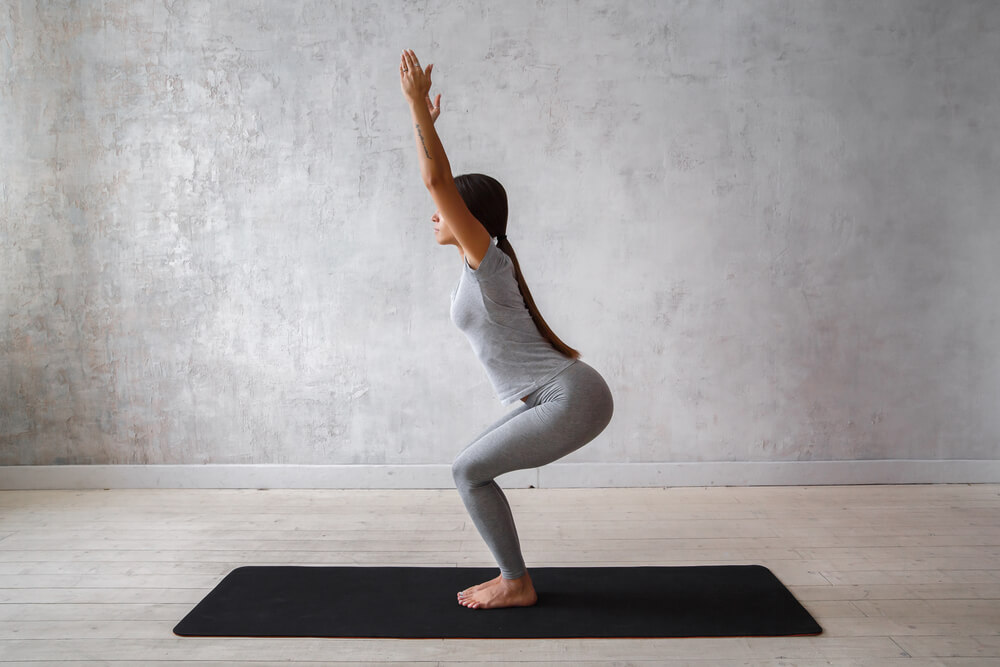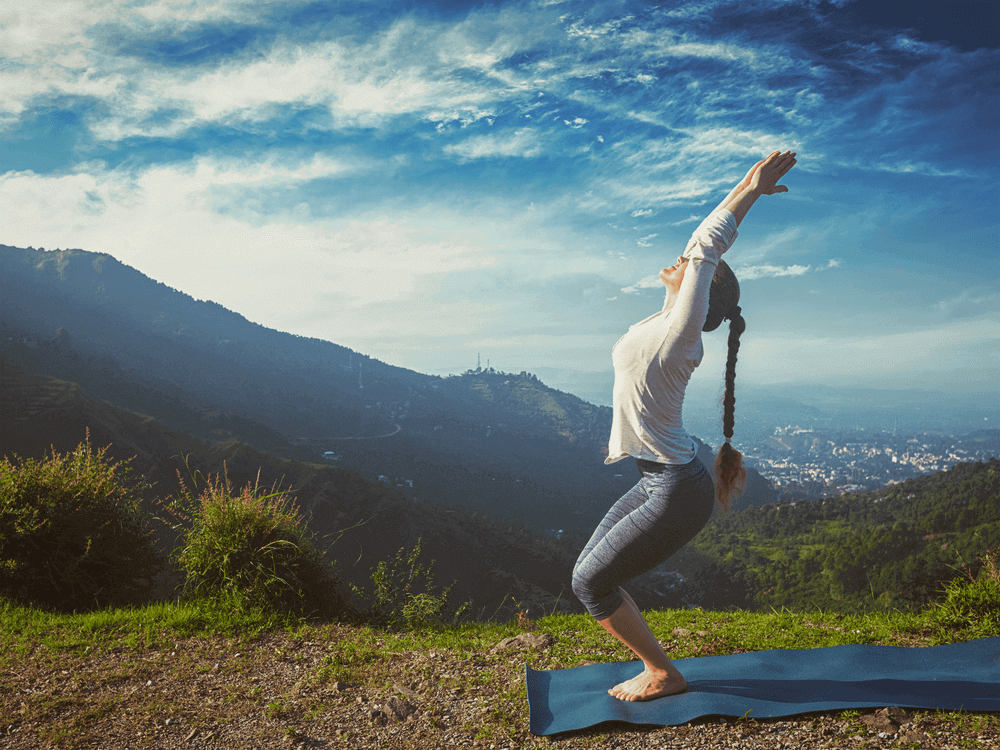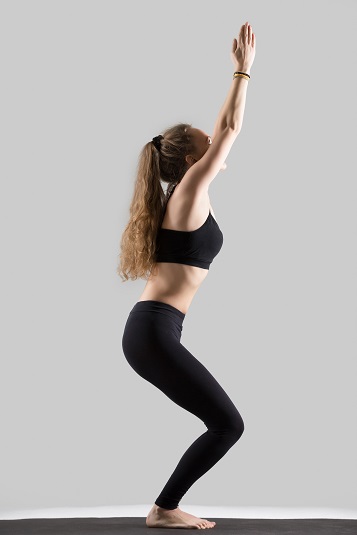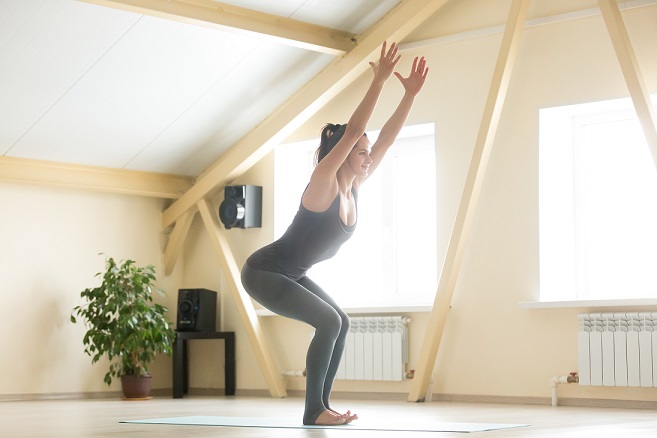Yoga is a powerful practice, and Utkatasana (Chair Pose) is a great example—it builds strength and focus, creating a sense of invisible support for both body and mind.
The view of this pose is that it looks like a practitioner is sitting in an imaginary chair, which is why its name in English is chair pose and “Utkatasana” in Sanskrit. However, “Utkatasana” in Sanskrit is also referred to as the Fierce Pose because ‘Utkata’ means violent and intense.
But why are the words intense and powerful used for Chair Pose? In ancient times, chairs were symbols of power and status. At that time, only kings, leaders, and powerful people could sit on chairs. That is why Chair Pose shows strength, control, and inner power in yoga.

Chair Pose teaches you to focus, be determined, and be committed. To hold the pose, you need to work your legs, arms, and core together while keeping your spine long and strong.
Let’s learn more about Utkatasana (Chair Pose) in detail. Here, you’ll find all the answers related to this pose, like what it is, how to perform it, its benefits, and other minor but important information.
What is Utkatasana?
“Utkatasana” is a beginner-level standing yoga pose, also known as a chair pose, because of its structured view. In Sanskrit, ‘Utkata’ means wild, intense, or fierce, while ‘Asana’ means posture. It’s believed that Krishnamacharya introduced the modern chair version of this pose around the 19th century.
Utkatasana might look simple—like a yogi sitting in an invisible chair—but it takes strength and focus to hold. Chair Pose is a strong, warming pose that helps build strength and brings your whole body together to work. It teaches focus, determination, and commitment.
In this pose, your legs, arms, and upper body strength are boosted. It also lifts your mid-centre and keeps your spine long. Performing this pose takes physical strength with mental focus. Because when you stay balanced and steady in the pose, you may feel a deep sense of energy and power inside you.

How to Perform Chair Pose?
Here are the complete steps to performing utkatasana chair pose:
- First, stand in Tadasana, inhale, and stretch your arms overhead.
- Rotate your biceps forward so they point toward your ears, and lower your shoulders until they are level with your ears.
- Now, make sure your hips face the front of the mat. Bend your knee with exaltation, ensuring it does not cross the toes.
- Turn your knees to lower your base, ensuring your thighs stay parallel to the ground. Lower into a half-squat, ensuring your mid-centre stays upright and doesn’t lean forward.
- Keep your inner thighs together and lower your thighs towards your heels.
- Focus on squeezing your shoulder blades together, pressing your tailbone toward the floor, and tilting your pelvis.
- Stretch your lower back, creating length through the spine.
- Keep your focus on one point at eye level.
- Hold the posture for at least 30 seconds to a minute.
- Inhale to straighten your knees and lift your arms, then exhale to release the posture.
Common Mistakes to Avoid
- Knees Going Past Toes: Performing Utkatasana yoga puts strain on the knees. So always keep your knees behind your toes, because it will protect you from a knee injury.
- Collapsing the Chest: You need to maintain a lifted chest and lengthened spine. Also, avoid rounding the back.
- Arching the Lower Back Too Much: Overarching can cause lower back discomfort. Gently lower your back and tighten your belly.
- Uneven Weight Distribution: Don’t lean forward onto the balls of your feet. Keep the weight evenly distributed, primarily through the heels.
- Tension in the Shoulders: Relax your shoulders away from your ears, even as your arms reach upward.
Variations of Chair pose
There are about 140 variations of Utkatasana in yoga, each offering different benefits for the body. Here are some famous variations of the Chair pose.
- Cactus Position: In this variation of Utkatasana, you need to extend your arms out to the sides at shoulder height, creating a cactus shape. This position helps stretch the shoulders and strengthen the upper body.
- Chair pose with a block: This is the simplest variation you can perform by using a block that supports the body in the squatting position, making it easier for those who struggle with balance. You can place the block under your hips for added support.
- Chair pose with a twist (Parivrtta Utkatasana): In this variation of Utkatasana, you twist your torso to one side while holding the squat. This stretches the spine, opens the chest, and builds strength and balance.
- Chair pose with a balance (Eka pada utkatasana): If you are comfortable enough to make it more challenging, try lifting one foot off the ground while in the squat, using the other leg to maintain balance.

Benefits of Utkatasana (Chair Pose)
Practicing Chair Pose (Utkatasana) regularly can benefit your body and mind in many ways. Because it helps improve strength, balance, and focus. Looking at each benefit one by one can help you understand how this pose works and how it affects your own experience.
1. Physical Benefits of Utkatasana
- Utkatasana may look like a simple yoga pose, but it is a powerful full-body workout pose that can be challenging. Because performing it can burn thigh fat, your calves become tightened, and your glutes engage.
- Your arms and midsection join in, helping to build strength throughout the body. Over time, this pose increases your stamina, helping you stay strong and steady on and off the mat.
- Regular practice can also make your body more flexible and improve blood flow. Holding the pose puts pressure on specific muscles, which helps to tone and strengthen them.
- Since many muscles engage at once, blood and oxygen flow in the body also improve. This can be good for your heart and overall health.
2. Mental Health Benefits of Utkatasana
- Utkatasana benefits are beyond physical benefits because it also helps to maintain healthy mental health.
- Because the Utkatasana pose is powerful and challenging to perform, it requires your full attention and focus. This automatically helps calm your mind and bring you into the present moment.
- The slow, steady breathing during the pose helps relax your body by calming your nervous system.
- Utkatasana lowers anxiety by activating the brain’s parasympathetic nervous system, which helps practitioners relax.
- Focusing on your breath and staying still in the pose is like a moving meditation. It gives your mind a break from daily stress and helps you feel more balanced and peaceful.

Utkatasana Contraindications
Blood Pressure Patients: People with low blood pressure can practice Utkatasana, but they should remember to wake slowly from the pose to avoid dizziness. People with high blood pressure should be cautious and avoid raising their arms overhead, as it may increase pressure. Keeping the arms at the heart centre is safer. It’s always best for individuals with either condition to consult a doctor or a yoga teacher before practising Utkatasana to ensure it’s safe for them.
Respiratory Complications: As this posture requires increased oxygen consumption, people with respiratory complications should avoid performing Utkatasana, especially if they have difficulty breathing deeply or experience shortness of breath.
Low Back Pathologies: People with low back issues should avoid overextending Utkatasana, because they can strain the lower back. Always consult a doctor or yoga instructor before attempting the pose.
Ankle, Knee, Hip, or Shoulder Injury: Because Utkatasana involves ankle, knee, hip, and shoulder strength, it will be hard for anyone who has recently had surgery in this area.
When and How to Include Utkatasana in Your Practice
Utkatasana has many variations, which makes it great for beginners. It’s also a versatile pose—you can use it in different parts of your yoga practice:
- Warm-Up: You can practise it as a warm-up because it gently wakes the legs and core of the body.
- Sun Salutation B: Another reason for this pose’s popularity is that the chair pose is commonly featured as part of Vinyasa flows in a sun salutation.
- Strength Training: Utkatasana (Chair Pose) helps build strength by working your legs, core, and arms all at once. It’s like a squat exercise, which also enhances balance and posture. Holding the pose for a more extended period strengthens your muscles and improves your stamina over time.
- Balance Work: Prepares the body for balance poses like Eagle Pose or Warrior III.
Also Read – Flight of Wisdom: The Spiritual and Physical Benefits of Eagle Pose
Conclusion
Now you know all about chair yoga poses, their benefits, contradictions, and all the other important details. However, the major part will be your willpower to add it to your daily routine and experience its benefits in a practical way. Whether you’re a beginner practitioner looking to build strength with this pose or an experienced yogi, the chair pose has something to offer.
Remember, it’s not about how long you can hold the pose or how perfect it looks—it’s about how slowly you make it part of your yoga journey.













